The Rise of @Horse_ebooks: A Bot Ahead of Its Time
More than a decade before an AI-powered chatbot could do your homework, help you make dinner, or pass the bar exam, there was @Horse_ebooks. This Twitter account, created in 2010, tweeted automated snippets from ebooks that took on unexpected and strangely poetic meanings when decontextualized. Despite its origins as a spambot, the account gained popularity for its absurdist fragments that went viral. Phrases like “Hello saxophone,” “COULD THIS BE THE,” and “Today we are lucky to be talking” captivated over 200,000 followers at its peak and still continue to resonate even though the account has been inactive for a decade. One of its most memorable quotes, “everything happens so much,” is still widely recognized today.
Unveiling the Human Behind @Horse_ebooks’ Quirky Tweets
In 2013, it was revealed that a human named Jacob Bakkila had been responsible for the tweets from @Horse_ebooks for the previous two years. Bakkila, an artist from New York City, had purchased the account from an actual spammer in 2012 and then took on the role of the bot, tweeting excerpts from books at random intervals. His goal was to reverse engineer how the bot approached internet content by pulling from previously written text. This project raised questions about the tension between authorship and the interplay between humans and bots. Bakkila explored when the bot ended and the human began in his simulation of @Horse_ebooks’ speech.
Language Learning Models and the Evolution of Chatbots
The @Horse_ebooks account functioned similarly to today’s more advanced chatbots by reusing and repurposing existing writing. Language learning models, the foundation of chatbot technology like ChatGPT, analyze patterns in human speech by crawling through vast collections of written text. These models then generate speech based on context clues and provide responses to users. Despite the growth in sophistication, it is essential to note that chatbots are still using language written by humans and providing it back to humans. The interaction between humans and chatbots continues to raise questions about the limits of AI and the fine line between human and machine authorship.
The Integration of AI in the Art World: Controversies and Creativity
The integration of AI into the art world has sparked both interest and controversy. While some perceive it as a threat, others view it as an opportunity for creativity and exploration. Artists using AI in their work often experiment with its capabilities and explore new possibilities. Although the controversies surrounding AI remain, it is crucial to recognize that people have always projected human-like traits onto machinery. From older chatbots like SmarterChild to today’s advanced models, AI has fascinated humans who tend to assign emotional and interactive qualities to these technologies. How AI impacts the art world and its future implications still remain to be seen.
@Horse_ebooks and the Enduring Fascination with AI in the Digital Age
@Horse_ebooks’ resonance with people highlights the enduring fascination with AI and digital technologies. The bot’s quirky and unexpected tweets captured the attention of thousands of followers. In an era where technological advancements like AI dominate conversations, @Horse_ebooks stood out as an early example of a language-based bot that engaged the public in a viral way. The current boom in AI-powered chatbots, therapists, and friends reinforces the continuous human interest in exploring and interacting with these technologies. As AI evolves, the question of what it means to be human and the interplay between humans and bots becomes even more intriguing.
Analyst comment
Positive news:
The Rise of @Horse_ebooks: A Bot Ahead of Its Time
Positive impact on the market: This news highlights the enduring fascination with AI and digital technologies, indicating a growing market for AI-powered chatbots and related technologies. It suggests potential opportunities for businesses working in this field.













